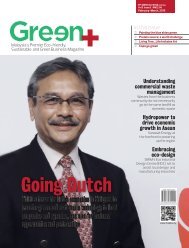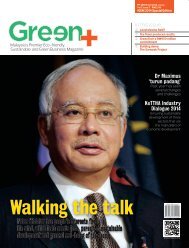Green+ Malaysia's Premier Eco-friendly, Sustainable and Green Business Magazine
SIRIM - Technology Provider
SIRIM - Technology Provider
You also want an ePaper? Increase the reach of your titles
YUMPU automatically turns print PDFs into web optimized ePapers that Google loves.
ENERGY<br />
Ahmad Shadzli (left) <strong>and</strong> Chin.<br />
their alternatives for democratization<br />
of the electricity supply market that<br />
can be achieved by commercializing<br />
of Rooftop PVs for all without quota<br />
limits with means like the Net Energy<br />
Metering Program added in that may<br />
avail investors to get their payback<br />
from such investments in less than 10<br />
years without recourse to premium FiT<br />
payment by SEDA. Their request to the<br />
authorities concerned, like KeTTHA<br />
<strong>and</strong> SEDA, to increase the FIT allocation<br />
for up to 400MWp by 2017 has been<br />
ongoing. These figures are derived from<br />
comparing with the geographical region<br />
current PV Capacity Targets from 2014,<br />
2020 <strong>and</strong> 2030 with other countries<br />
where it’s very positively applicable<br />
<strong>and</strong> can be done with political will <strong>and</strong><br />
support for this infinite energy from the<br />
sun. (Refer to Fig1).<br />
MPIA presented their case of<br />
solar PV market scenario <strong>and</strong> energy<br />
capacity usage with the 2014 Global PV<br />
Utilization chart. Malaysia is seen to be<br />
only having about 200MWp of installed<br />
capacity by end 2014 compared to other<br />
countries like China (34,000MWp),<br />
Japan (12,000MWp), Korea (1,500MWp),<br />
Thail<strong>and</strong> (800MWp) <strong>and</strong> Taiwan (~<br />
350MWp).<br />
Comparing 2014 against 2020, there<br />
are exponential percentage growth<br />
projections in capacity ranging from<br />
nearly 300% for China (100,000MWp),<br />
Japan (28,000MWp, 230% increase),<br />
Korea (~6,000MWp or~400% increase),<br />
Thail<strong>and</strong> (3,000MWp or 375% increase),<br />
Taiwan (4,500MWp or 1285% increase)<br />
<strong>and</strong> Singapore increasing from 45MWp<br />
in 2014 to 600MWp (1,300% increase) by<br />
2020 projection out of which 350MW (<br />
or 770% increase) are designated to be<br />
investments by the Singapore government<br />
itself.<br />
These figures signify the convincing<br />
commitment by major Asian countries<br />
including our neighbour’s commitment<br />
to invest in the future on PV, putting<br />
<strong>Business</strong> Spin Offs of PV Industry<br />
Local Manufacturing of Solar PV<br />
Components<br />
RM 300 million for<br />
local steel<br />
manufacturing<br />
industry<br />
JOB CREATION<br />
6000 new generation of highly<br />
skilled workers<br />
600 technicians /supervisors<br />
100 Engineers<br />
<strong>Eco</strong>nomic Benefits<br />
RM 300 million for<br />
domestic electrical/<br />
electronic industries<br />
RM 150 million for<br />
local <strong>and</strong> international<br />
consultancy<br />
RM 45 million for R<br />
& D <strong>and</strong> training<br />
DC<br />
Circuit<br />
Breakers,<br />
DC fuses,<br />
DC SPd’s<br />
Malaysia Current PV Target <strong>and</strong> Comparison with other<br />
Countries<br />
Geographic R egion<br />
Current<br />
cumulative<br />
I nstalled<br />
capacity (MWp)<br />
in 2014<br />
Target<br />
Capacity in<br />
2020<br />
(MWp)<br />
Target capacity<br />
in 2030<br />
(MWp)<br />
Target % Solar<br />
PV<br />
Contribution<br />
To<br />
Energy mix<br />
China 34,000 100,000 20%<br />
Japan 12,000 28,000 53,000 10%<br />
India 2,200 20,000<br />
Korea 1500 ~6,000<br />
Thail<strong>and</strong> 800 3,000<br />
Taiwan ~350 4500 6,300<br />
Malaysia 200<br />
FI T - 400<br />
(2017)<br />
Singapore 45 600 (350 MWp<br />
by Govt)<br />
confidence in solar energy. By harnessing<br />
the energy from the sun, it is<br />
without doubt the way forward, as it is<br />
safe, independent <strong>and</strong> one of the most<br />
plentiful, reliable <strong>and</strong> non-depleting<br />
resources. No inhibitions or concerns<br />
of inflationary costs like feed-stocks<br />
purchasing, preparation or transportation<br />
<strong>and</strong> distribution cost or from any<br />
untoward price increase or crisis of a<br />
finite nature.<br />
Moreover, it may be in the long<br />
term the most suitable green solution<br />
to reduce costs <strong>and</strong> CO2 emissions. It<br />
will also benefit the Electricity supply<br />
players by relieving them from the<br />
need for high investment costs for<br />
utilities planting up, reducing need for<br />
heavy grid distribution investments<br />
<strong>and</strong> maintenance costs <strong>and</strong> reducing<br />
4.8% in 2025<br />
Australia 3,800 2,800 23,000 20% by 2020<br />
green+.2014, november-december 17





